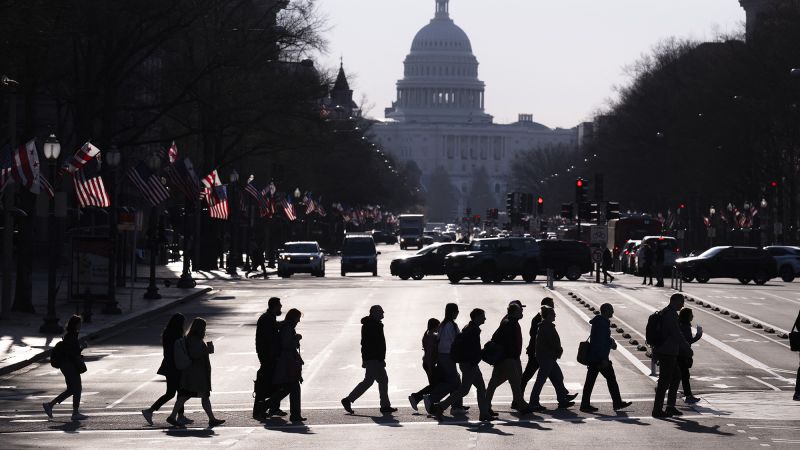The government’s employment report for May, which is anticipated to be disclosed at 8:30 a.m. ET on Friday, is poised to offer critical insights regarding the ramifications of President Donald Trump’s erratic tariff policies on American workers. This report could potentially denote the early effects of trade policies that have fluctuated significantly, creating uncertainties in various sectors of the economy.
According to forecasts gathered from FactSet estimates, the consensus is that the U.S. economy has seen a moderation in job growth, with an expected addition of 130,000 jobs in May, contrasting with an unexpectedly strong surge of 177,000 jobs in April. Additionally, the unemployment rate is projected to remain steady at 4.2% for the third month consecutively, indicating some stability in the job market, albeit with caution regarding its growth momentum.
In an interview with CNN, Claudia Sahm, the chief economist at New Century Advisors, remarked on the current labor market, stating, “The labor market is good, but it’s not exceptional, and we’re in the process of putting some real strain on the economy.” This sentiment reflects a broader concern that underlying economic pressures are beginning to surface, influencing employment stability.
A notable example is highlighted through the experience of Jordan Williams, who, after nearly a year of searching for employment, secured a position with Passenger Clothing, an outdoor apparel company aiming to expand its U.S. operations. Based in the U.K., the firm had successfully established partnerships with retailers like REI and Scheels, exciting Williams as he anticipated growth opportunities culminated in his role.
However, this optimistic outlook quickly reversed in April when President Trump announced significant tariffs on imported goods. This event, which Williams referred to as “Liberation Day,” profoundly impacted his employment. The imposition of tariffs transformed the U.S. market from a vital opportunity for Passenger into a looming threat, as the company announced extensive duties for importing materials, severely limiting their operational capacity in the country.
As a result, Williams officially lost his job on April 11. This abrupt termination is seen as a precursor to potential broader labor market repercussions stemming from unpredictable tariff implementations under the Trump administration. Economists have cautioned that such layoffs could foreshadow wider economic fallout impacting workers across various industries.
The latest weekly jobless claims report from the Labor Department has also indicated an uptick in first-time claims, further underscoring potential challenges in the labor market. Recently reported figures showed that first-time claims reached approximately 247,000 filings, a notable increase marking the most substantial weekly total since October 2024. Concurrently, continuing claims, which encapsulate those receiving unemployment insurance for extended periods, approached three-and-a-half-year highs.
This nuanced labor market showcases hiring fluctuations amidst uncertainty. According to Nela Richardson, chief economist for ADP, the current economic climate has led to unpredictable employment dynamics where businesses hesitate to hire due to uncertain economic conditions. “This is a market where there are stops and starts, and there are pullbacks in hiring,” she elaborated. Although hiring rates slightly increased to 3.5% in April, they remain below levels witnessed before the pandemic.
Telling statistics illustrate that private sector job growth has considerably diminished over recent months, with ADP recording significant drops in hiring activities during April and May, raising concerns about the overall labor market’s trajectory. However, Richardson clarified, “The weak numbers we’re seeing now do not point to a labor market that’s collapsing, but there is hiring hesitancy.”
The subsequent wave of layoffs reverberates throughout different sectors, particularly within the federal workforce, which has encountered job losses for three successive months. Recent data indicated a drop of nearly 13,000 federal jobs in February, 4,000 in March, and 9,000 in April. Moreover, job cut announcements in 2023 have surged in comparison to prior years, greatly influenced by initiatives aimed at enhancing government efficiency.
As a result, the alarming job cut figures—exceeding 294,000 attributed to government-related cost-cutting measures—reflect the compounded impacts of tariffs and broader economic conditions. Analysts like Andrew Challenger from Challenger, Gray & Christmas have highlighted that consumer spending, overall economic pessimism, and employer hesitance contribute to these challenges.
Moving further along into May, layoffs have continued to be a significant focus though the monthly total recorded in May indicated a decrease from April. However, the ongoing scrutiny reveals that job cut announcements through the first five months of 2023 have drastically increased compared to the previous year’s figures, culminating in a considerable rise in overall layoffs.
While the data suggests a complication in hiring dynamics, current layoffs and jobless claims remain below pre-pandemic levels. Sahm emphasized the potential longer-term impacts of tariffs, indicating a slow burning effect that could unfold over time. As such, she noted, “We are still early days,” hinting at the complexities ahead for the U.S. labor market in adapting to these challenges



